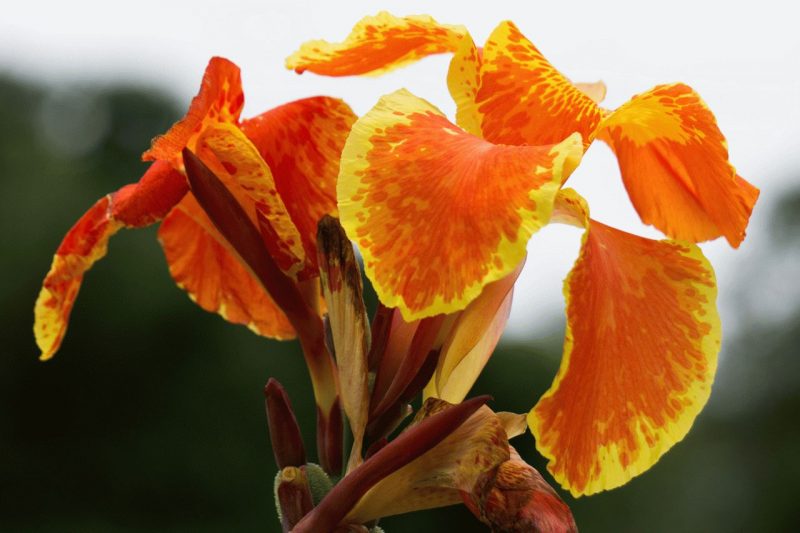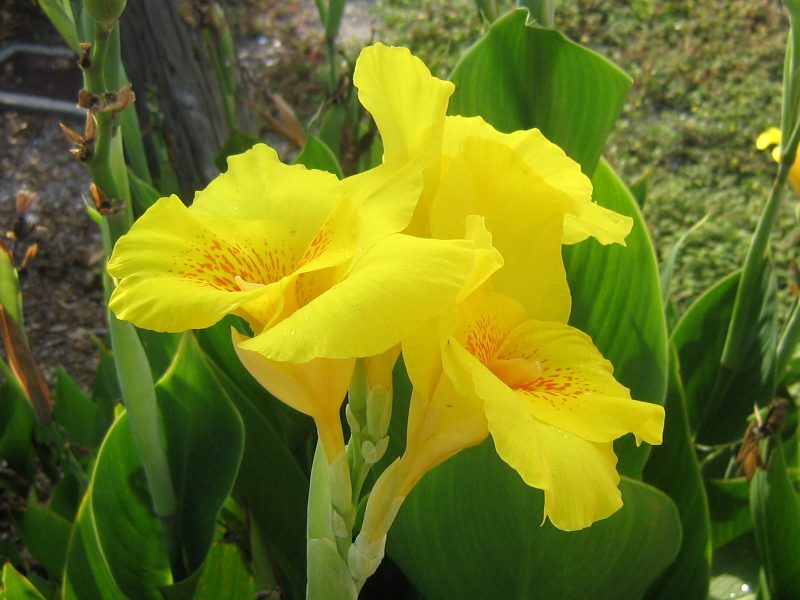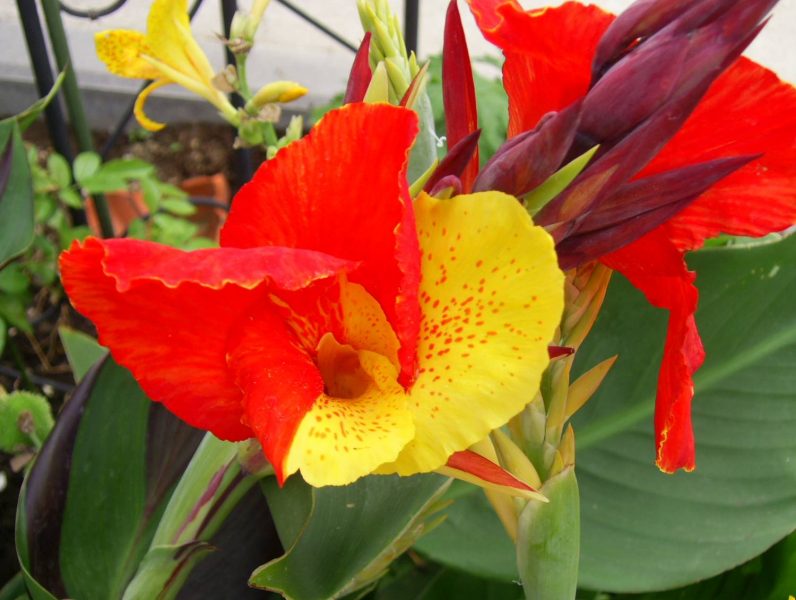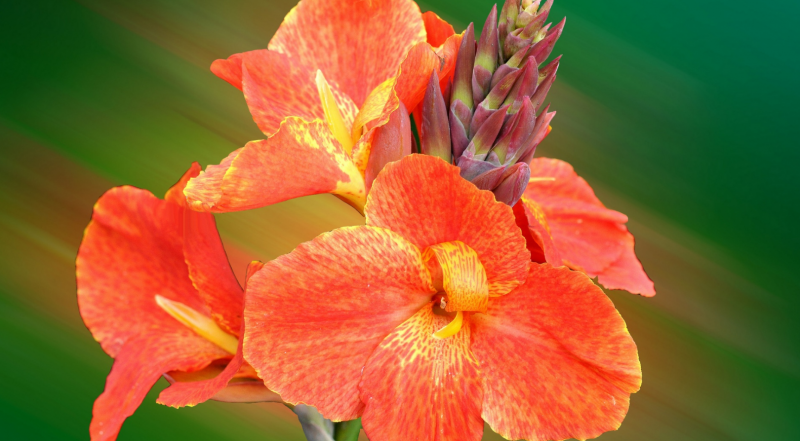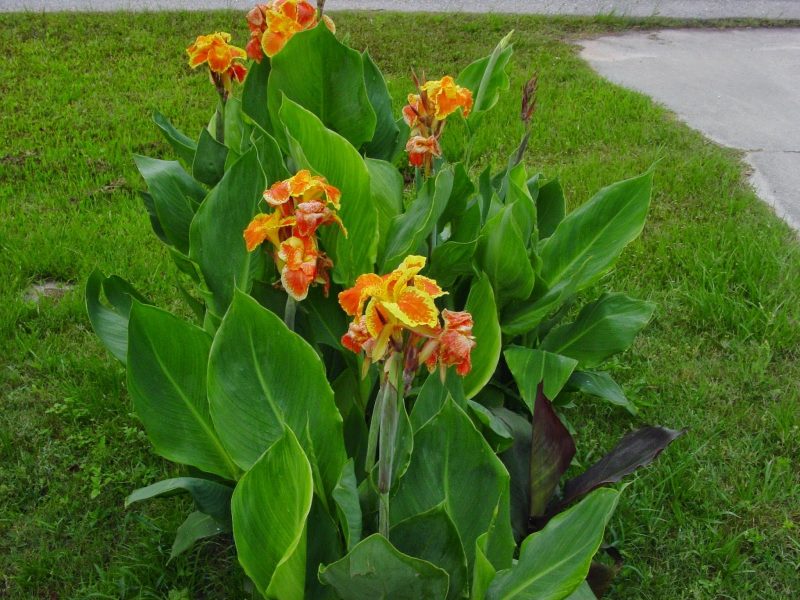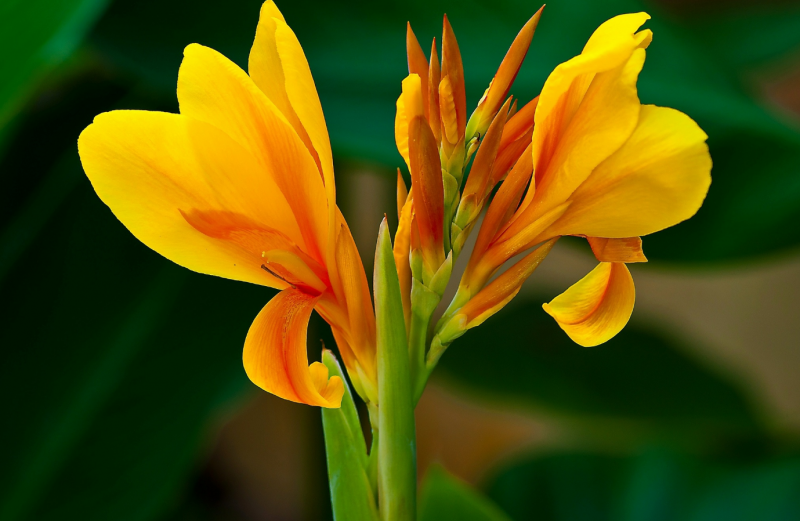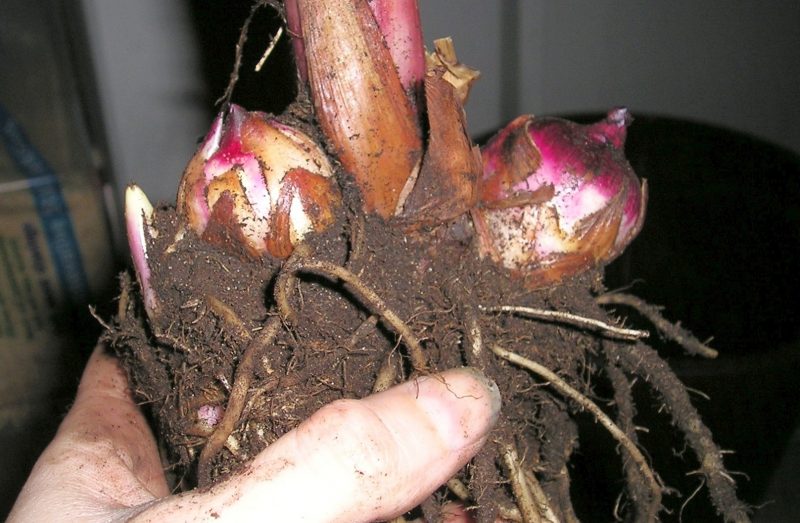A plant, the cultivation of which seems an impossible task with just one look at it. Powerful shrubs with large dense leaves, crowned with unusual inflorescences resembling either an orchid or a gladiolus ... Still, planting a canna and caring for it in open ground and protected, upon closer examination, is not so difficult.
Material Content:
Varieties for growing in the garden
There are many classifications of cannes: by the shape of inflorescences, by the nature of their color, by the height of the bush, by the color of leaves. The easiest way to divide the cannes into 2 groups according to the terms of highest decorativeness is early flowering (from mid-June to early September) and late-flowering (from mid-July to frost).
Based on the fact that some varieties do not disappear from garden catalogs for many years, we can judge about their special popularity.
Among these favorites:
- ‘Richard Wallace’ (‘R. Wallase’) - late flowering green leaf cannon with large yellow inflorescences up to 25 cm long. Height - up to 130 cm.
- ‘Striata’ (‘Striata’) - mid-early variegated canna. The color of the flowers is orange-yellow, the height of the bush is 90-120 cm.
- ‘Lucifer’ (‘Lucifer’) - a late-flowering green leaf variety of Cannes, carries inflorescences up to 20 cm long, red with a yellow border. Height 80-90 cm. There is a dwarf form ‘Lucifer Dwarf’ - 50 cm.
- ‘President’ (‘President’) - late flowering canna with green leaves and large bright red flowers up to 12 cm in diameter, is decorative all season. Bush height up to 100 cm.
- ‘Angel Martin’ (‘Angel Martin’) - a mid-early variety of Cannes with velvet brown-green leaves and pink-apricot inflorescences. Bush height 90-100 cm, dwarf кар Dwarf Angel Martin ’- only 25-30 cm, usually used in container planting.‘
How to grow cannes in open ground
In the natural environment, canna grows in the tropical regions of South America and the Hindustan Peninsula, and therefore it cannot tolerate the harsh winters of climate 3, 4 and even 5 USDA zones. This culture requires a special growing regime similar to gladioli, dahlias, and other heat-loving tuberous bulbous plants.
Outdoor landing
Tuberous rhizomes of Cannes are removed from the store (or buy new ones in a flower shop) in February-March in order to begin their germination. This is necessary so that by the time the flowers of the canna are planted in the ground, they already have well-developed shoots and leaves. Early germination ensures timely flowering.
Pre-germination
Rhizomes are disassembled by the number of free-sprouting processes, old and dry thin roots are removed. If the dividers cannot be disassembled by hand, then use a sharp knife, and open sections are treated with crushed coal or ordinary green, give them a little airflow.
Badly wintered tubers are only cleaned of rot and solids, and put on whole germination, and they are divided into small parts after the appearance of green sprouts or immediately before planting in the ground.
Prepared delenki planted in boxes or pots with a moist earth mixture consisting of fertile soil, peat and sand (or sawdust) in a ratio of 2: 1: 0.5. Depth of landing is 2-3 cm.
The first sprouts usually appear after 7-10 days. Containers with dividers are kept at a temperature of + 23-25 ° C in a bright room. Moderate watering: add several crystals of potassium permanganate or phytosporin to warm water (10 drops per 1 tbsp of water).
Read also:outdoor vinca planting and care
Landing at a permanent place
In open ground, grown delenki planted in the second half of May. At the bottom of a deep landing pit (up to 40 cm) lay a 10-centimeter layer of semi-overripe manure, cover it with 20 cm of fertile soil. This will provide lower heating for the thermophilic culture and growing canna flowers will be easier.
Delenki with sprouts planted at a depth of 7-10 cm at a distance of 0.5-0.6 m from each other.
Immediately after planting, treat with Zircon - for the quickest adaptation of the plant to new conditions. If there is a threat of freezing frost, you need to cover the cannes with a non-woven fabric.
How to care for flowers
At first, newly planted plants need timely watering, weeding and loosening (or mulching). As soon as the first signs appear that the canna has grown, you can give the first top dressing. Beautiful flowering occurs only in healthy and powerful bushes, therefore, once every 2 weeks, watering with diluted (1:10) slurry or chicken droppings (1:15) is used. Before each feeding, preliminary watering with clean water is necessary.
Interesting! In nature, cannes often grow in swamps, so they prefer abundant hydration. Even a series of hybrids серия Longwood ’has been created, specially designed for landing in the coastal zone of a reservoir.
Flowering stimulation
When the first flower stalk appears, phosphorus-potassium fertilizers are introduced into the cannas menu. This can be a ready-made mixture, for example, potassium monophosphate (5-10 g per 10 l of water), or composed independently: 20 g of double superphosphate + 15 g of potassium sulfate per 10 l of water.
A good result is the use of flower fertilizers with trace elements. For example, Crystal, Aquaris or Solution. Cannes are gaining inflorescences in full force, blooming actively and for a long time, and the rhizome is well developed and better adapted to winter storage conditions.
Why cann’t bloom?
- The plants did not go through the preliminary germination procedure and simply did not have time to bloom at the right time.
- The cannon landing site should be in the open sun, in a place protected from drafts.
- Proper care of the cannons was not provided, and therefore the plant is sick or affected by pests.
It is interesting:daylilies in open ground
The nuances of care after flowering
The decorativeness of the culture is supported by the regular removal of wilted canna flowers. Care in the garden for her stops only with the first frost. When the temperature drops to zero, the bushes should be covered with 15 cm dry peat or humus. And in late October - early November, you can start digging rhizomes.
Attention! 2 weeks before the proposed work, watering must be stopped.
The bush is first dug from all sides, the aerial part is cut 15-20 cm from the ground. They take out the rhizomes with a pitchfork, trying to keep the earthen clod as much as possible. If traces of diseases are found (rot, mold, spots), then these places need to be cut with a clean sharp knife and treated with green or wood ash.
Plant propagation
Varietal cannons are bred only in a vegetative way - by dividing rhizomes in the spring (after removal from storage). After this, the delenki are sent for germination. Indian Canna (species) is easily propagated by seeds. They retain viability for a long time and after scarification (violation of the integrity of the hard shell of the seed) sprout literally within a week.
Seedlings are developing rapidly and by the end of May they can already be planted in open ground. Care for them is the same as for those grown from rhizomes.
The disadvantages of seed propagation of cannes:
- plants later bloom - at best, not earlier than August;
- small, undecorated flowers;
- taken from varietal specimens, do not repeat the maternal qualities in terms of flowers and leaves.
Pests, diseases and their treatment
Kanna is considered a viable culture, little susceptible to pests (due to a completely absent smell). Only slugs who like fleshy leaves and succulent flowers, and even aphids, can flatter it. In addition to its usual mission - inhibition of the growth of young shoots on the canna - it can become a carrier of viral leaf damage - cucumber mosaic. Therefore, the fight against insects should be started at their first appearance: with a soapy solution, wash the surfaces of leaf blades on both sides, trying not to spill it on the ground.
The appearance of brown spots on the leaves indicates a rust lesion. The fungus appears in conditions of high humidity, especially in the root of the neck. First of all, the affected leaves are removed, after which the diseased plant and all cultures surrounding it are sprayed with a fungicide based on copper sulfate - a Bordeaux mixture. A solution of manganese (5 g per 10 liters of water) is also suitable, which is used to treat not only plants, but also the surface of the earth under them. After 5-7 days, the procedure is repeated.
Favorable conditions for the development of gray rot are crowding of plants, their overmoistening at low air temperature, and an excess of nitrogen in the soil. First there is a whitish fluffy coating on the buds, stems and flowers. Then these areas acquire a brownish tint and soften, and the leaves acquire a dark border and completely die off.
Attention! Long autumn rains lead to the formation of rot on the rhizomes, so they must be cleaned immediately after digging and treated in a fungicide solution.
Cannes in the winter
Fans of this flower try to grow a tropical canna as a home plant all year round, but the traditional way of wintering for it is to store it in a cellar or refrigerator. Winter is a time of rest for a thermophilic guest.
Storage Methods for Cannes:
- A rhizome, dug with a lump of earth, is planted in a spacious pot with nutrient soil.They put it in a bright and cool room, for example, on the floor by the balcony door, moderately water it and keep it until spring.
- Rhizomes do not shake off adhering earth, only slightly dry. Then they are placed in spacious boxes with moistened peat or sawdust and placed in the cellar, where the temperature is kept within + 5–8 ° С, and air humidity is 70-80%. Occasionally, the state of the rhizomes will need to be checked.
- After digging, the rhizomes are well washed with water, soaked according to the instructions in a fungicide such as Maxim or in a solution of potassium permanganate. Hemp is cut short, the treated rhizomes are dried at a temperature of + 18-20 ° C for several days. Then they are wrapped in paper (newspapers, for example) and sent for storage in the vegetable compartment of the refrigerator (+ 4-6 ° C). Once every 2 weeks, corms should be viewed to prevent the possible spread of rot.
Magnificent garden cannons attract attention due to their impressive appearance, monumentality and long decorative effect.



